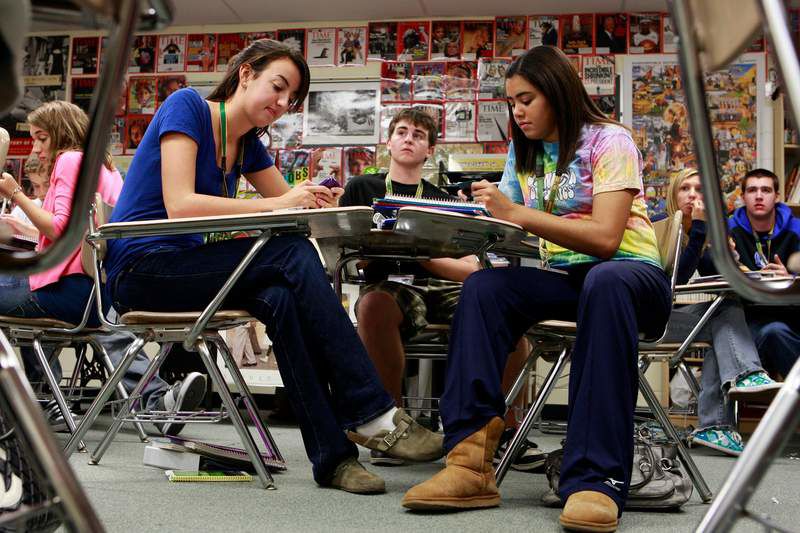Rather than fight it, schools embrace cell phone use
Published 5:00 am Tuesday, October 19, 2010

- Julia Ostoich, from left, David Parzynski and Kayla Price use cell phones to look up information on political races during a Social Science Survey class at Fremd High School in Palatine, Ill., earlier this month.
CHICAGO — With the election weeks away, Fremd High School teacher Jason Spoor asked students in his government class, some of them first-time voters, to research local candidates vying for office.
They would have 15 minutes and one learning tool: their cell phone.
“If you are driving down the street and headed to vote, you don’t have a computer at the touch of a hand. You have a cell phone,” Spoor told his students last week.
The lesson would have been impossible in the past. But with cell phones tucked in the book bags and pockets of three-fourths of today’s teens, many high schools are ceding defeat in the battle to keep handheld technology out of class and instead are inviting students to use their phones for learning.
Under a teacher’s guidance, students might record themselves speaking a foreign language, text an answer to an online quiz or send themselves a homework reminder.
“It’s one of those things — if you can’t beat them, join them,” said Jill Bullo, principal of Wheaton North High School, which plans to review its policy this year.
As a first step, Wheaton administrators allowed students to use cell phones before and after classes last year, instead of requiring them to be powered off at all times.
It is the latest twist in the debate about how schools react to the gear that students carry with them every day.
An estimated 83 percent of 17-year-olds across the country have cell phones today, according to a report released in April by the Pew Internet and American Life Project. That grew from 64 percent five years earlier. Among all high school-age students, 75 percent have them.
Younger children were less likely to have cell phones, research showed. But even among 12-year-olds, 58 percent reported owning one compared with 18 percent in 2004.
Across all ages, nearly eight of every 10 students surveyed carried their phone with them to school every day, the study showed.
“Every year, it seems to trickle down one more grade level,” said Liz Kolb, author of “Toys to Tools: Connecting Student Cell Phones to Education.”
Redialing the rules
Confronted with such widespread use, many schools are redialing the rules.
Educators say they attempt to balance the opportunity to boost student learning with the concerns of classroom distractions or cheating.
“If I was teaching a class and all the students had their phones and someone was texting them or they used the device to communicate with other students about material on a test … that’s when it becomes problematic,” said Greg Fantozzi, principal of Kaneland High School in Maple Park, Ill., where teens must stow their phones in lockers during the school day.
What’s more, many phones come equipped with cameras and video, which make teachers and administrators “a little nervous about potentially bad things they can do,” Bullo said. “If it were a simple phone, it would be different.”
Still, York Community High School Principal Diana Smith plans to sit down this week with students to talk about the possibility of their using cell phones for academic purposes. The Elmhurst school currently requires that phones remain off during the day.
“What we know about kids now is they are used to having so many sources of technology available to them,” Smith said. “I think we need to be in step with them on it.”
In writing new cell phone rules, some schools offer training seminars to show teachers how to make good use of the gadgets.
Glenbrook North High School now provides sessions for teachers on “how can you leverage what they have in their pockets,” technology coordinator Ryan Bretag said. Similar primers are provided for students. The north suburban district began allowing students to use cell phones at a teacher’s discretion when they revamped the personal technology policy last year.
‘A natural step’
Glenbrook senior John Cram pulled out his phone during a lab experiment in his material science class this fall. He wanted to measure the porosity of a cupcake. Using the camera in his cell phone, Cram took a picture, e-mailed it to himself and then imported the image to Photoshop, where he could more precisely measure each air pocket to calculate the cupcake’s porosity.
“It was out of necessity, really. It was just a natural step,” Cram said of turning to his cell phone.
On a recent Wednesday, Fremd students huddled in groups to research candidates for state and federal office, their thumbs dancing across the palm-sized screens. Of the 31 students in class, only one did not have a cell phone. Others had two.
“Double productivity,” senior Lucas Lassila quipped, holding a cell phone in each hand.
For students who forget their phones or don’t have one, Spoor makes phone-related assignments group activities. Some educators keep a cell phone or iPad to loan students for classroom use.
Teacher Jason Spoor said he asks students for their e-mail addresses and cell phone numbers at the start of the school year. Spoor — who asked the teens for pointers when he first bought an iPhone — said he often texts a reminder about big assignments, and he invites students to text or e-mail him in return.
“Look, this is just a part of who we are now,” Spoor said of the personal technology. “It’s a tidal wave.”






